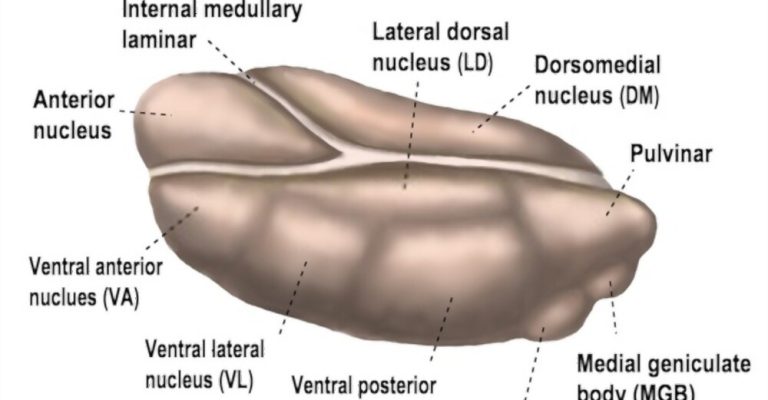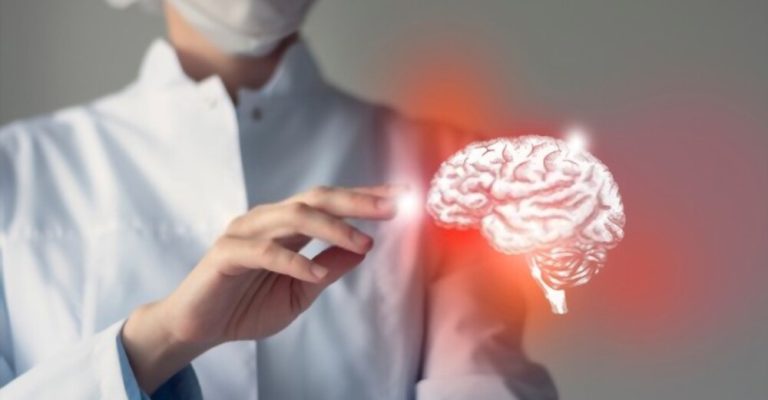
When we think of brain damage, some of the most obvious symptoms that come to mind are severe headaches or memory loss. However, one often overlooked area of the brain is the thalamus—a small structure situated deep within our skull and responsible for a range of bodily processes, including sensory reception, conscious thought, sleep-wake cycles, and emotion regulation.
Despite being relatively small in size, it has a critical function in many aspects of cognitive functioning, so when this vital organ suffers trauma (through stroke or head injury), the results can be far-reaching and devastating.
The thalamus is a large, egg-shaped mass of gray matter located deep within the brain. It serves as a relay center for sensory information. It plays a vital role in the brain’s processing of this information.
The thalamus is divided into two regions, the ventral and dorsal thalami, which are connected by a bundle of nerve fibers known as the commissural fibers. The ventral thalamus relays sensory information from the body to higher brain structures for processing.
In contrast, the dorsal thalamus is vital in establishing pathways that allow for motor control of voluntary movement. Additionally, it is involved in regulating sleep and wake cycles and controlling levels of alertness. Recent studies have also demonstrated its involvement in learning and memory formation.

The thalamus receives signals from all other parts of the brain. It directs them to their appropriate destination in the cortex. For example, it relays information from the visual centers of the occipital lobes to the regions responsible for conscious visual perception in the temporal lobe.
Similarly, it relays auditory information from the temporal lobe to areas for sound processing in the frontal lobe. It also directs information about body movements from primary frontal lobe motor areas to targeted muscles to control movement. Finally, it sends emotional cues from limbic structures, such as the amygdala, to relevant regions of the prefrontal cortex.
In addition to its role as a gateway for neural signaling pathways, recent studies have uncovered evidence that suggests that the thalamus may also play an essential role in cognitive functions such as attention and working memory.
For example, studies using functional magnetic resonance imaging (fMRI) have shown that activity in specific thalamic nuclei can correlate with cognitive performance on tasks involving sustained attention or working memory. This suggests that these nuclei may be involved in modulating activity throughout widespread cortical networks responsible for these tasks.
Overall, research has revealed that the thalamus plays an integral role in regulating both conscious awareness and cognitive processes through its unique ability to serve as a hub connecting multiple brain regions together into unified systems capable of complex thought processes.
It is clear that the thalamus plays a role in a wide variety of essential processes. Thus, thalamus injury can have varying consequences depending on the victim. The following are some of the most frequently experienced signs of thalamic dysfunction:
Damage to the thalamus can cause significant changes in mood and mental functioning. People may experience depression, anxiety, or irritability. In severe cases, they may have difficulty concentrating, be easily distracted, or display inappropriate emotions. It can also lead to memory loss and difficulty in forming new memories.
Thalamic damage can lead to cognitive impairments, such as speech comprehension or production difficulties. Many people affected by thalamic damage struggle with a slowed ability to process information and impaired concentration. They may also find it difficult to multi-task or follow instructions.
Damage to the thalamus can result in abnormal sensations such as a burning sensation in the limbs, tingling in the extremities, or hypersensitivity to touch or sound. It can also cause hearing problems or vision loss due to disruptions in how the brain processes signal from the senses.
Thalamic damage can lead to motor disabilities, including paralysis of one side of the body (hemiplegia), weakness on one side of the body (hemiparesis), decreased coordination, balance issues, tremors, and an overall decrease in muscular strength. Furthermore, some people experience dysphagia (difficulty swallowing) due to weakened muscles used for swallowing.
Other complications may include:
Comas are another possible outcome of significant damage to the thalamus, which regulates falling asleep and wakefulness.

The possibility of recovering from thalamus damage depends heavily on the extent of the injury and how long it has been present. Damage to the thalamus can be caused by number of factors, including stroke, brain hemorrhage, trauma, or tumors. Sometimes, a patient may recover some functioning depending on where the damage is located within the thalamus and how much of it has been affected.
In partial thalamic lesions, only portions of sensory information are often impaired while other regions remain functional. For example, if an individual sustains a lesion in their right thalamus, they may have difficulty interpreting visual input from their left eye but find that sound perception is spared.
In addition, depending on the severity of the damage, doctors may be able to rebuild pathways between neurons that were blocked due to injury or illness using treatments such as physical rehabilitation and occupational therapy.
In more severe cases involving large portions of the thalamus being damaged, individuals can relearn essential skills, including communication, movement, and self-care. This process typically begins with neuropsychological testing to evaluate cognitive abilities before beginning rehabilitative therapies such as speech-language pathology and physical therapy.
Occupational therapy is also often helpful in regaining lost motor skills and retraining muscle memory. In addition, brain stimulation techniques such as transcranial magnetic stimulation (TMS) can also help patients regain lost abilities or develop new neural connections between neurons to promote recovery from brain injuries like those associated with damage to the thalamus.
Regaining lost skills will be at the center of treatment for thalamic impairment. There is a plethora of options for doing so. The following therapies may help recover from thalamic damage:
Sensory reeducation exercises can be a helpful tool in treating thalamus damage. These exercises are designed to help the person relearn the sensation and perception of the body’s senses by engaging them in activities that involve sight, sound, touch, taste, and smell.
For example, a sight exercise might involve reading text or a book aloud while following along with a finger on the page. Touch exercises can involve tracing letters or symbols on hands or arms with different textures, such as sandpaper or velvet fabric.
Taste exercises are usually used in conjunction with smell exercises as they help to enhance one another. Examples may include:
Smell exercises can be done by having someone smell different essential oils, such as lavender or rosemary, while attempting to identify which one they’re smelling. Finally, sound exercises help people distinguish sounds better than before when their thalamus was damaged.
Post-traumatic trembling can be effectively treated with deep brain stimulation (DBS). Implanted sensors are used in deep brain stimulation, which sends high-frequency impulses to the thalamus. Tremors can be completely wiped out by transmitting that signals.
Furthermore, thalamic activation has been shown to improve cognitive function following brain damage. Therefore, people with thalamus damage will benefit even more from this. However, DBS is a surgical procedure with risks and potential adverse effects like impaired speech and coordination issues.
Aphasia is a situation wherein you have trouble synchronizing your motions because of harm to the thalamus as a result of a brain injury. Some symptoms include unsteady movement and an inability to grasp things.
Since apraxia rarely impacts muscular power, stimulating neurogenesis is the most effective treatment. The key is to repeat the actions you care about until you can do them with ease again.
Common treatment strategies for thalamus damage may include exercises to increase range of motion, orthopedic manual therapy techniques designed to improve mobility, balance activities that help decrease the risk of falls, and cardiovascular exercises to improve circulation and overall fitness.
Additionally, physical therapists may use modalities such as ultrasound or electrical stimulation to reduce inflammation, promote healing, and alleviate pain associated with thalamus damage.
When the thalamus is damaged, it can cause problems with movement and sensation. The good news is that brain restructuring can help with both of these problems. However, due to the thalamus’s versatility, every damage will manifest slightly differently. So it is essential to collaborate with your healthcare providers to determine the treatment options that will be most effective for you.